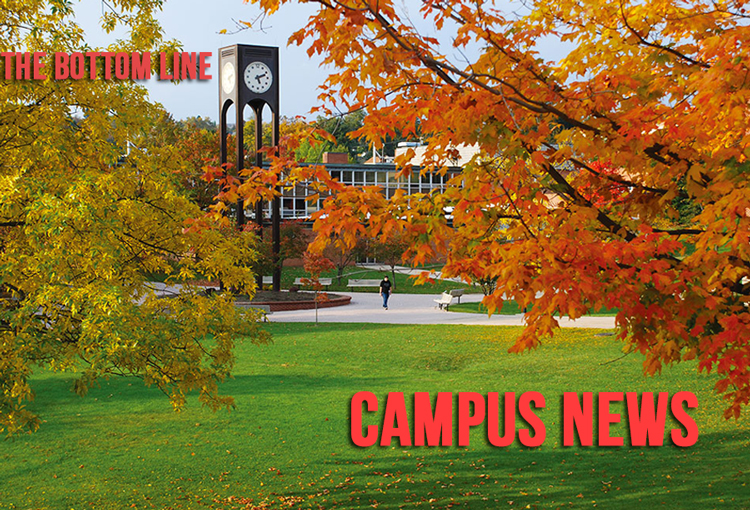The Circle of Life: Sustainability at Frostburg Dining
From Learning Green; Living Green, Frostburg State University’s sustainability initiative, to Frostburg Grows, a project in which FSU converted an abandoned coalmine into a greenhouse, the university has made it a priority to develop sustainable practices on the campus and in the community.
The same goes for Chartwells Dining Services, the food service contractor hired by FSU in 2014 to replace Aramark Dining.
In fact, sustainability is part of what brought Chartwells and FSU together.
As part of the contract bringing Chartwells to FSU, the university requested that Chartwells contribute to the university’s sustainability mission.
“It was a request through the contract proposal that sustainability would be a large component of what we would do,” said David Glenn, director of dining services at FSU. “They wanted to see what we could do to be more sustainable.”
Now, Chartwells is holding up its end of the deal. Frostburg Dining recently initiated a new composting program.
“We threw out some ideas, and one of them was a composter, and that was the one that stuck,” said Glenn. The idea to start composting at Frostburg Dining is somewhat unique.
According to Glenn, some schools also create compost from food waste, but Chartwells does not handle the composting process. Frostburg Dining handles the composting process. “As far as I know, no other Chartwells account is composting, at least not on the east coast,” he said.
The Rocket
“The actual process doesn’t cost us a dime, but the equipment is a different story,” Glenn said.
Chesapeake Dining Hall recently underwent significant renovations; as part of the renovations, a more efficient dishwasher, a new dish accumulator, and, of course, a composter—“The Rocket”—were added.
The Rocket is the brand name of the composter. According to Tidy Planet, the company that invented this particular composter, “The Rocket Composters are designed to recycle food wastes from catering or food service on site. By recycling these wastes on site the need for costly collection and disposal for the waste is eliminated and a useful end product is produced instead.”
“The process starts with the food that comes through the door,” said Glenn, explaining that pre-consumer waste and post-consumer waste are processed in the composter.
Pre-consumer waste is waste from food preparation, such as the leaves from a pineapple. Post-consumer waste is simply food left on plates by patrons. Pre-consumer waste is ground up in a muncher.
“All the food waste gets ground up through this [food] pulper, which gets 80-90 percent of the water out, then it goes into the centrifuge, which gets all of the water out of it, and then it gets dropped in a bucket,” explained Glenn. “We have to clean this tube every night. It’s pretty gross,” he joked.
Five gallons of food are mixed with five gallons of wood chips and five gallons of finished compost. Finished compost is needed for the first four to six weeks of composting to help build up microbes and pathogens that help create new compost that stays at the optimal temperature and retain maximum nutritional value.
“It takes about 10-14 days for the product to go in from one side and out the other as a finished compost product,” said Glenn. “Once we start getting finished compost, that’ll go to Frostburg Grows.”
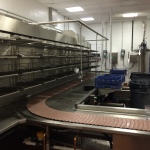
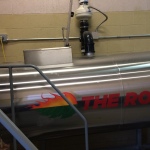
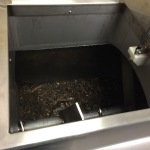
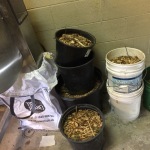
Sustaining and Growing Frostburg
Frostburg Dining and Frostburg Grows have developed a strengthening relationship since Chartwells came to Frostburg in the Summer of 2014.
“We buy a lot of produce from them, and we’re working to get even more,” explained Glenn. “We just worked out a schedule with [Frostburg Grows Project Coordinator] Cory [Armstrong] and his guys to start claiming tomatoes and other products. We’re actually going to start getting product in April,” said Glenn.
Due to the region’s climate, local produce is difficult to obtain, according to Glenn, who projects they will be able to get local produce from April until October. Some produce may still be available in November.
“Knowing that sustainability was a big deal on campus, we sort of sought out the local farmers to see what’s going on,” said Glenn. “Frostburg Grows is actually linked to the campus so the idea was always there.”
Frostburg Grows acts like a local co-op, and other local farmers are involved. Glenn said that they will look to other local farmers for things they can’t get from Frostburg Grows. A timetable hasn’t been placed on when Frostburg Dining will begin receiving product from other local farmers, but Glenn estimated that will happen around April 2015.
Glenn emphasized the significance of buying locally and the effect it can have on sustainable practices.
“You’re reducing your carbon footprint. We’re not buying product that was made in California, shipped to the east coast, and driven in a truck to Frostburg. It’s putting back into the local community, and it helps sustain jobs and the local economy,” said Glenn.
Glenn added, “And it’s usually a better product because it’s grown locally,” explaining that locally bought tomatoes are “nice and juicy, just like they are when you get ‘em at home.”
Project Clean-Plate
Chartwells’ sustainability efforts aren’t limited to composting and buying locally; educating the consumer about sustainability is essential to the company. Chartwells is beginning a new program designed to encourage consumers to be more eco-friendly.
“We’re working on a project right now called Project Clean Plate,” said Glenn. “We’ll be rolling that out in the dining hall over the next week or so where we’ll do a little education so students can see how much food is being wasted.”
For the past couple weeks, Frostburg Dining has weighed the amount of food waste, and they are going to set a baseline to show how much food was wasted on average.
“For every pound of food that you decrease over the next month and a half, we’re going to donate a pound of food to a local food bank,” said Glenn. “We’ve done this at other campuses, and it’s a big way to show students what’s going on. It’s a good program.”
A cost is associated with the food that gets wasted, and Project Clean Plate helps lower that cost. If product costs decrease, students may receive incentives.
“If you can take your product cost down a little bit, there’s more money to do some special nights, like a steak night,” said Glenn.
Glenn emphasized, “Hey, let’s not waste food. It’s the right thing to do.”
The Circle of Life
“Recyclemania is coming up and I’ve challenged our team to get involved more than just composting. How can we recycle at catered events? How can we recycle in our offices? How can we do a bigger job for the campus?
“The guy who came down to show us the composter and train us was pretty impressed with the circle of life. We’re buying compost from a local company, we’re composting waste from that product, and the compost is going back to help produce the product that we’re buying.” He added, “We’re trying to do our part a little bit at a time.”

